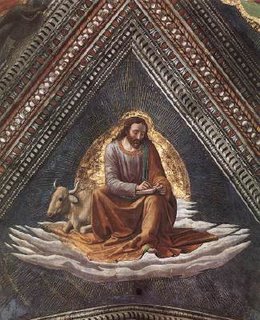 ST LUKE EVANGELIST
ST LUKE EVANGELISTLuke was born in Antioch to pagan Greek parents. St. Paul met him at Troas and invited him to accompany him into Macedonia where they traveled first to Samothrace, Neapolis, and finally Philippi about the year 51. Later, he became the constant companion of St. Paul, following him everywhere. He alone remained with Paul when he was imprisoned in Rome about the year 61. After St. Paul's death, St. Luke left Rome. There are conflicting reports about where he went. Some say he preached in Greece, others in Gaul. He wrote his Gospel with the aim of attracting the Gentiles to the goodness and mercy of the Lord. A little later he wrote the Acts of the Apostles. He died without shedding his blood, but the Church honored him with the title of martyr for the long sufferings and mortifications he endured for the cause of the Gospel.
Comments of Prof. Plinio:
We will analyze the special graces the Our Lord gave to St. Luke through the certain facts we know about his life. He was the companion of St. Paul, the author of one of the four Gospels, and also author of the Acts of the Apostles. We can imagine the moral qualities of a man chosen by St. Paul to be his companion on trips. He would have to be a man eminently able to assist St. Paul's apostolic activities. He would have an extraordinary apostolic ardor and a special gift to form and deal with the new disciples that St. Paul was attracting to the Catholic Faith. He also was able to understand the life of Our Lord Jesus Christ so profoundly that the Holy Ghost chose him to collect the data of His life and write it. Analogously, he understood perfectly the life of the nascent Church and wrote about it in the Acts of the Apostles, which is the first report of the History of the Church.
To do those three things he must have been a true vessel of the Holy Ghost. The graces one receives reading the Gospel of St. Luke and the Acts of the Apostles certainly come to us from the Holy Ghost. But they also reflect the soul of St. Luke who wrote them. The light of the Holy Ghost comes to us through the stained glass windows of his writings. There are special characteristics in those writings that are his alone. It is also known that he was very devoted to Our Lady. The first painting of Our Lady is attributed to him. The Painting is known and venerated as Salus Populus Romani in the Basilica of Santa Maria Maggiore in Rome. I suppose that Our Lady did not pose for him, but rather that he saw her many times and had her figure in mind to reproduce in a painting. So, we can imagine him silently admiring this or that facet of her physiognomy, and then reproducing it in the picture he was painting. Another time, he would perhaps glimpse another aspect and retouch his painting. What a marvelous work that would be - with Our Lord blessing him from Heaven and the Angels smiling at his labor to perfect in his painting the face of the Queen of Heaven and Earth. All this is beautiful and grandiose, and we cannot find sufficient words of praise for his life. We cannot describe it, but only admire it. I believe that by admiring the soul of St. Luke, a little of his extraordinary qualities and virtues may trickle into our souls.
The picture of St Luke the Evangelist is from fresco in Cappella Tornabuoni, Santa Maria Novella, Florence, 1486-90





























